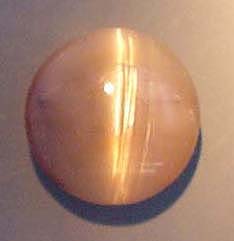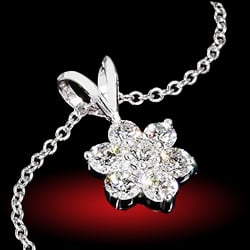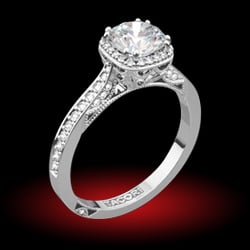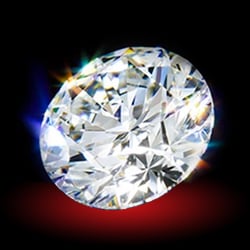You are using an out of date browser. It may not display this or other websites correctly.
You should upgrade or use an alternative browser.
You should upgrade or use an alternative browser.
Wifes new/old cats eye chrysoberyl...
- Thread starter C Smith
- Start date
- Status
- Not open for further replies. Please create a new topic or request for this thread to be opened.
- Joined
- Mar 26, 2006
- Messages
- 15,467
movie zombie
Super_Ideal_Rock
- Joined
- Jan 20, 2005
- Messages
- 11,879
- Joined
- Feb 17, 2004
- Messages
- 1,104
I spot tested it on the refractometer and came up with a range of 1.75-1.77 . It was tough to do though. The mount would not allow the cabochon to stand free so I had to keep the lid of the instrument open in a darkened room to get a reading as I manually held the ring in place. Richard, do you have any further suggestions for RI testing mounted cabochons like this one? I don't like having the lid up as I fear that compromises the readings. Thoughts?Date: 8/19/2006 3:23:03 PM
Author: Richard M.
Have you tested it? I'm just curious about the spot R.I. I've never seen a chrysoberyl c.e. quite that color. It's a pretty stone.
Richard M.
The stone is UV and chelsea filter inert.
The light and dark side do trade off depending on light direction. It likewise does present the opening and closing phenomena when turned but not so dramatically as others I''ve seen.Date: 8/19/2006 3:59:08 PM
Author: RockDoc
As you turn the ring, does the eye ''open and close''?
Does the ''dark side'' change position as it is turned on the horizontal axis?
Rockdoc
- Joined
- Feb 17, 2004
- Messages
- 1,104
The only thing I can think of is to remove the stone from the setting. Trying to balance cabs in settings can be difficult. Maybe you could balance it better in a Jemeter or another type of reflectivity meter if you have access to one although I have no experience testing cabs with them. Good luck.
Richard M.
Richard M.
Lynn B
Ideal_Rock
- Joined
- May 9, 2004
- Messages
- 5,609
open culet
Rough_Rock
- Joined
- Jan 27, 2006
- Messages
- 16
Hi,
The ring is lovely. It does look a lot like quartz in the pictures. Looking at the belly of the stone may help in identification. Chrysoberyl cat''s eyes seldom have flat bellies. The belly would look more like the belly of a natural star sapphire. If it is indeed chyrsobery, the value would be very high. I would invest in a cert.
The ring is lovely. It does look a lot like quartz in the pictures. Looking at the belly of the stone may help in identification. Chrysoberyl cat''s eyes seldom have flat bellies. The belly would look more like the belly of a natural star sapphire. If it is indeed chyrsobery, the value would be very high. I would invest in a cert.
You may be right. I tried to replicate my initial RI results and ended up with an inconclusive reading. I took a few more pics with the stone on the polarizer of my polariscope to see the internal structure and coloration a bit better. The stone is flat-bottomed and displays it's eye even in low light... Here are the additonal pics;Date: 8/20/2006 7:46:46 AM
Author: open culet
Hi,
The ring is lovely. It does look a lot like quartz in the pictures. Looking at the belly of the stone may help in identification. Chrysoberyl cat's eyes seldom have flat bellies. The belly would look more like the belly of a natural star sapphire. If it is indeed chyrsobery, the value would be very high. I would invest in a cert.



All images were taken under a 10x loupe. What do they tell you? As it is, I'll be happy if it is quartz simply because it is beautiful and I will have a new experience to add to my gemology education. Besides, I paid an amount barely greater than the golds dump value

Date: 8/19/2006 10:10:15 PM
Author: Lynn B
Very cool ring, thanks for sharing!
Now, if I may ask... how did you get those photos into your post (particularly the post with two photos) without doing an attachment???!!! Thank you!!!
Lynn
I hosted the pictures off-site and then I simply used the insert image function which is the two mountain peaks with a sun icon in the post/reply toolbar to get the pics to show up in the post. It takes awhile for the site to upload the reply though. Patience is required

- Joined
- Feb 17, 2004
- Messages
- 1,104
As always, the disclaimer that identifying a stone from an image is really impossible. But since you asked, here''s my two-points''-worth....
Applying Occam''s Razor, chrysoberyl just doesn''t fit for me. First off, chrysoberyl stones of that size are very hard to find and NEVER come calibrated (you say yours is 14 x 12 mm.) and almost never flat-bottomed. A couple of years ago one of my Asian suppliers sent me a nearly 16-carat chrysoberyl cat''s-eye to sell for him. It was an oval and I forget the exact dimensions but it certainly was a ''free'' size oval that required a custom setting.
A chrysoberyl will probably display the ''milk-and-honey'' effect when rotated 360 degrees under a point light source like a penlight. To my eye the color''s wrong for chrysoberyl. But it''s very ''right'' for the many cat''s-eye type tiger''s-eyes I''ve seen and worked with over the years. The German factories in Idar-Oberstein used to turn those out in great commercial quantities, including bleached ones that really do look much like some yellowish chrysoberyl c.e.''s from Brazil and India.
There are other ''eye'' minerals of similar color: sillimanite and a few opals roughly similar to yours like the accompanying image.
Richard M.

Applying Occam''s Razor, chrysoberyl just doesn''t fit for me. First off, chrysoberyl stones of that size are very hard to find and NEVER come calibrated (you say yours is 14 x 12 mm.) and almost never flat-bottomed. A couple of years ago one of my Asian suppliers sent me a nearly 16-carat chrysoberyl cat''s-eye to sell for him. It was an oval and I forget the exact dimensions but it certainly was a ''free'' size oval that required a custom setting.
A chrysoberyl will probably display the ''milk-and-honey'' effect when rotated 360 degrees under a point light source like a penlight. To my eye the color''s wrong for chrysoberyl. But it''s very ''right'' for the many cat''s-eye type tiger''s-eyes I''ve seen and worked with over the years. The German factories in Idar-Oberstein used to turn those out in great commercial quantities, including bleached ones that really do look much like some yellowish chrysoberyl c.e.''s from Brazil and India.
There are other ''eye'' minerals of similar color: sillimanite and a few opals roughly similar to yours like the accompanying image.
Richard M.

Years ago, in the early 80''s, I saw a synthetic, Chrysoberyl CE that had the milk and honey affect that a very experienced dealer bought on 47th St as being natural. It was incredibly convincing looking.
It fooled him, so as "punishment" to himself he wore it to remind himself that buying things for a "song" was not the most prudent thing to do.
Kyocera, I think was the manufacturer of a lot of synthetic chrysoberyl. ( Look for a small "K" on the belly of the stone).
From memory I don''t remember the testing to separate natural from synthetic, I''ll have to look it up when I get some time, but this is certainly a candidate to send to AGTA. You might call them to see if they can do it while set, but probably ''smart'' to have it unset and send it to them.
The staff there has some of the best gemologists on the globe.
Rockdoc
It fooled him, so as "punishment" to himself he wore it to remind himself that buying things for a "song" was not the most prudent thing to do.
Kyocera, I think was the manufacturer of a lot of synthetic chrysoberyl. ( Look for a small "K" on the belly of the stone).
From memory I don''t remember the testing to separate natural from synthetic, I''ll have to look it up when I get some time, but this is certainly a candidate to send to AGTA. You might call them to see if they can do it while set, but probably ''smart'' to have it unset and send it to them.
The staff there has some of the best gemologists on the globe.
Rockdoc
- Joined
- Feb 17, 2004
- Messages
- 1,104
Date: 8/20/2006 1:27:34 PM
Author: C Smith
Thanks for the input Richard. This stone does alternate light and dark as seen in the image below. Will quartz or synthetics display this in your experience? I guess I''ll have to give the refractometer another go
I''ve got some quartz ''eyes'' kicking around somewhere but can''t lay hands on them at the moment. I think some may show the effect in your images but can''t say for certain without checking. I''ll keep looking as time allows. The translucence of your stone does reinforce the argument for chrysoberyl IMO.
As for synthetics, I''m not aware that c.e. chrysoberyl has ever been made. In his 1997 "Synthetic, Imitation & Treated Gemstones," gemologist Michael O''Donoghue wrote: "The cat''s-eye chrysoberyl has not yet been synthesized as it''s fairly easy to make a convincing imitation."
Removing your stone from the setting and obtaining accurate R.I. and S.G. should sort it out. If it doesn''t, GIA will do an identification-only for moderate cost.
Richard M.
Richard Sherwood
Ideal_Rock
- Joined
- Sep 25, 2002
- Messages
- 4,924
FireGoddess
Super_Ideal_Rock
- Joined
- Jan 25, 2005
- Messages
- 12,145
belle
Super_Ideal_Rock
- Joined
- Nov 19, 2004
- Messages
- 10,285
path914
Rough_Rock
- Joined
- Aug 1, 2005
- Messages
- 41
One fairly easy way to check to see if it is a fiberoptic glass material is to shine a strong light (I use a bright led flashlight) horizontally on one side of the stone and look closely on the opposite side where it shines through. Most of the fiberoptic material I''ve seen will have small, orderly hexagonal shapes visible that strongly indicate a man-made material.
- Status
- Not open for further replies. Please create a new topic or request for this thread to be opened.
Share:














300x240.png)